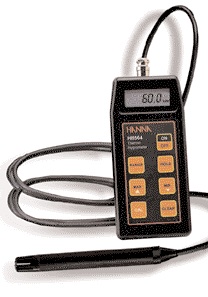Humidity is a measure of the amount of water vapor in the air. It is generally reported as relative humidity, absolute humidity, or dew point temperature.
Hygrometers
Capacitive Hygrometer
Capacitive hygrometer sensors use a capacitor that is sensitive to the amount of water vapor in the air to measure humidity.
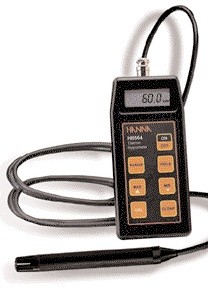
General Information
A capacitor is composed of two adjacent metal plates insulated from each other by a dielectric . The capacitance depends on the area of the plates and the distance between them.
In capacitive hygrometer sensors, changes in the amount of water vapor in the air alter the capacitance. This change in capacitance is proportional to a change in relative humidity.
There are two types of capacitance hygrometer sensors: thin-film polymer sensors, such as the one in the picture below, and aluminum-oxide sensors.
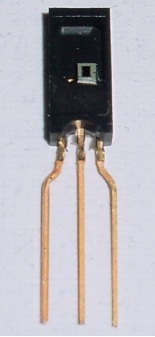
Equipment Design
Thin-film polymer sensors generally have four layers, shown in the schematic. The bottom layer is a glass or silicon substrate that acts as the support for the capacitor. A metal electrode is placed on the substrate and covered with a thin film of polymer. The thin-film polymer is then coated with a porous metal layer, which is the top electrode. The water vapor travels through the porous metal layer and is absorbed by the polymer, changing its capacitance. The change in capacitance is proportional to the change in the relative humidity.
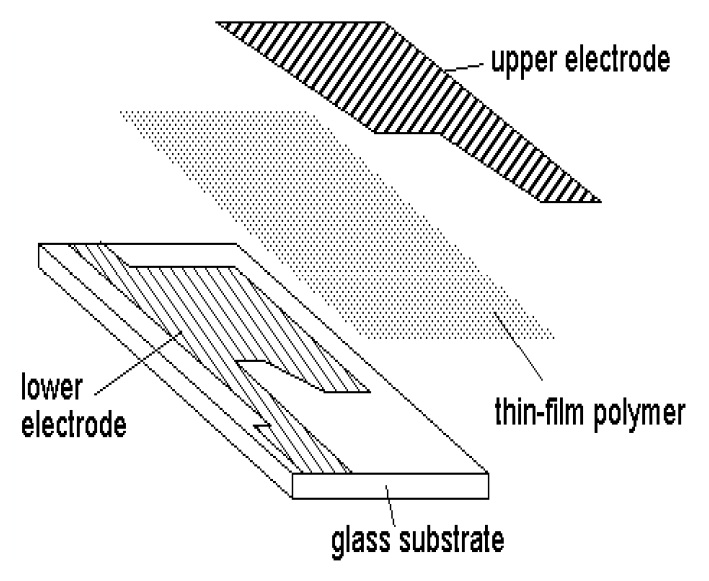
The picture below shows a thin-film polymer capacitance sensor. The sensor is very small, 5.0 mm x 3. 8 mm x 0.4 mm.

Aluminum-oxide sensors are formed by depositing a layer of porous aluminum oxide on a conductive substrate and then coating the aluminum oxide with a thin film of gold, as shown below. The conductive substrate and gold film are the sensor’s electrodes. The aluminum oxide acts as the sensor’s dielectric.
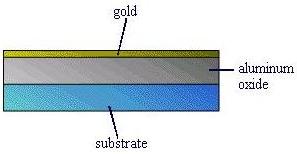
Water vapor penetrates the gold film and is absorbed by the aluminum oxide. This absorption changes the capacitance, reflecting a change in relative humidity.
Usage Examples
The hand-held hygrometer pictured below that is being used to measure the relative humidity in a greenhouse has a thin-film polymer sensor.
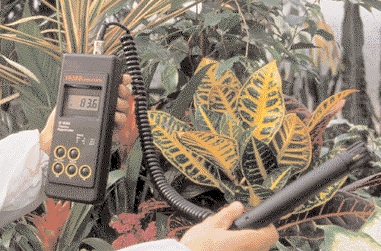
Thin-film polymer sensors are also useful in chemically aggressive atmospheres, such as chlorinated air or livestock facilities, in which ammonia may be present in the air.
Aluminum-oxide sensors are commonly used in petrochemical applications, such as in the refinery pictured below. In general, they are used in many of the same applications as thin-film polymer sensors.
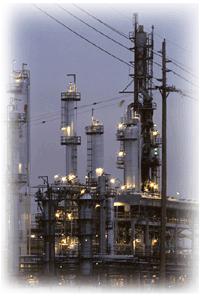
Advantages
- Small.
- Can measure wide range of humidities.
Disadvantages
- Must be periodically calibrated to accommodate hysteresis and contamination.
- Temperature can affect electrical characteristics, causing inaccurate readings.
- Prolonged exposure to relative humidities over 85% can cause inaccuracy in readings.
Resistive Hygrometer
General Information/Equipment Design
Variations in ambient relative humidity produce variations in resistance. This occurs in certain moisture-sensitive materials such as hygroscopic salts and carbon powder. In resistive hygrometer sensors, these materials are applied as a film over an insulating substrate and are terminated by metal contacts. The components of a resistive hygrometer sensor are represented below. As air passes over the film, changes in resistance vary with changes in relative humidity. Pictured below on the left are two resistive hygrometer sensors. Notice their small size.

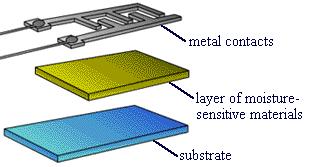
(Copyright Ohmic Instruments Co., Easton, MD)
Usage Examples
Humidity measurement and control is important in textile and paper industries. It is also key in drying processes. The resistive hygrometer sensor shown here is used to measure the humidity in stacks of paper, textile and cardboard.

Condensation-Type Hygrometer
General Information/Equipment Design
A condensation-type, or chilled mirror, hygrometer, shown here in the schematic, consists of a mirror that is cooled until dew or frost forms on it. The surface can be cooled with compressed carbon dioxide, dry ice, liquid air, or by mechanical refrigeration. In most designs, the condensation on the mirror surface is detected by optical or electrical techniques . The surface temperature of the mirror at condensation is the dew point temperature.
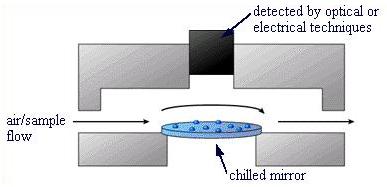
Usage Examples
Since condensation-type hygrometers measure dew point temperature very accurately, they are generally used as a secondary standard for calibrating lower-level humidity instruments.
Some chilled mirror hygrometers, such as the one pictured here, not only measure dew point temperature, but relative humidity and pressure as well.

Advantages
- Accurate over wide temperature spans.
- Minimal errors.
- Virtually self-calibrating.
Disadvantages
- For designs that do not measure other humidity parameters, dew-point must be converted.
Other
Humidity Indicating Cards
Humidity indicating cards have color-changing spots that indicate relative humidity.
General Information
In humidity indicating cards, such as the one shown here, color change indicates a change in humidity. Each spot is designed for a specific humidity range. When the humidity is below that range, the spot is blue. When it’s in the middle of the range, the spot is generally lavender, and at the top of the range the spot appears pink.

Equipment Design
Humidity indicating cards are made of blotting paper and the spots are cobalt chloride solutions. Different additives in the solutions enable the spots to cover a large range of relative humidity.
Cards can also be designed to indicate multiple levels of humidity. Such cards contain several spots that change color at different humidities.
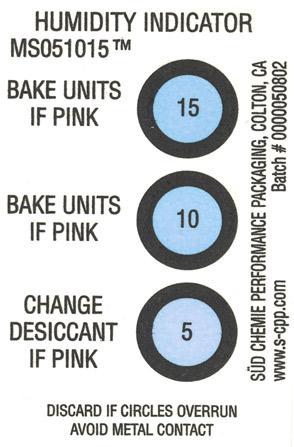
Usage Examples
Humidity indicating cards are placed in a package or container and are observed through built-in windows. They should be placed in a shaded position and normally in the lower or middle portion of the container, since humidity within the container will vary from top to bottom when exposed to sun or heat.
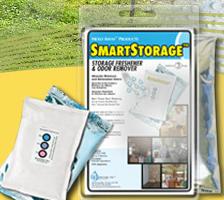
Humidity indicating cards are commonly used in pharmaceutical, medical diagnostic, and optical component packaging. They can be designed to indicate relative humidity as low as 5% to as high as 95%.
Advantages
- Fast acting.
- Portable.
- Do not lose calibration.
- Can be stored indefinitely in air tight containers.
- Relatively inexpensive.
Disadvantages
- Generally accurate only within +/- 5% relative humidity.
- Sometimes a temperature correction is necessary.
- Exposure to extreme heat, prolonged sunlight, and normal outside conditions for more than six months will turn the blue indication color to a greenish-blue.
- Exposure to ammonia and hydrazine will damage indicators.
Psychrometer
General Information/Equipment Design
Psychrometers consist of two thermometers: wet and dry bulb. There are two types of psychrometers: sling and aspirated.
In a sling psychrometer the wet bulb thermometer is spun to get air flow over the wet thermometer bulb.
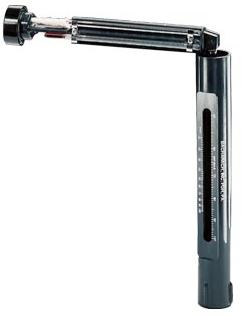
The movie below shows the operation of a sling psychrometer. Notice the temperatures before and after the psychrometer is run. The temperature on the left is the wet bulb temperature, which is lower than the dry bulb temperature. This is because the wet bulb temperature reflects the cooling due to the evaporation of water surrounding the thermometer bulb.
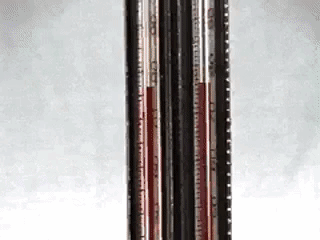
Most sling psychrometers give a relative humidity measurement once the wet and dry bulb temperatures are known. If a sling psychrometer is not designed to give such a measurement, a psychrometric chart is used to find the humidity parameters.
In aspirated psychrometers, as pictured below, a fan blows air across the wet thermometer bulb . The psychrometer gives wet bulb and dry bulb temperature readings. Once the wet and dry bulb temperatures are known, information from a psychrometric chart can be used to find humidity parameters. Since there is no need to swing the meter as in the sling type, aspirated psychrometers are easier to use in tight spaces.

Advantages
- No spinning is required to operate an aspirated psychrometer.
Disadvantages
- Moving air must be used.
Acknowledgements
- AGM Container Controls, Inc., Tucson, AZ
- Bacharach, Inc., New Kensington, PA
- Belfort Instruments, Baltimore, MD
- Desiccare, Inc., Pomona, CA
- Hanna Instruments, Woonsocket, RI
- Michell Instruments, Ely, UK
- Ohmic Instruments Co., Easton, MD
- ROTRONIC AG, Bassersdorf, Switzerland
- Sierra Monitor Corporation, Milpitas, CA
- Vaisala, Inc., Woburn, MA
- Yankee Environmental Systems, Inc., Turners Falls, MA
References
- Blinn, Bruce G. “Properties and Uses of Color Change Humidity Indicators.” Humidity and Moisture: Measurement and Control in Science and Industry . Ed. Robert E. Ruskin. London: Chapman & Hall, Ltd., 1965: 602-605.
- Considine, Douglas, M. Process/Industrial Instruments & Controls Handbook . 4th ed. New York: McGraw-Hill, Inc., 1993. Print.
- Lenk, John D. Handbook of Controls and Instrumentation . Englewood Cliffs, New Jersey: Prentice-Hall, Inc., 1980. Print.
- Perry, Robert H. and Don W. Green. Perry’s Chemical Engineers’ Handbook . 7th ed. New York: McGraw-Hill, Inc., 1997: 12-13. Print.
Developers
- Melissa Schlosser
- Steve Wesorick
- Kelsey Kaplan

